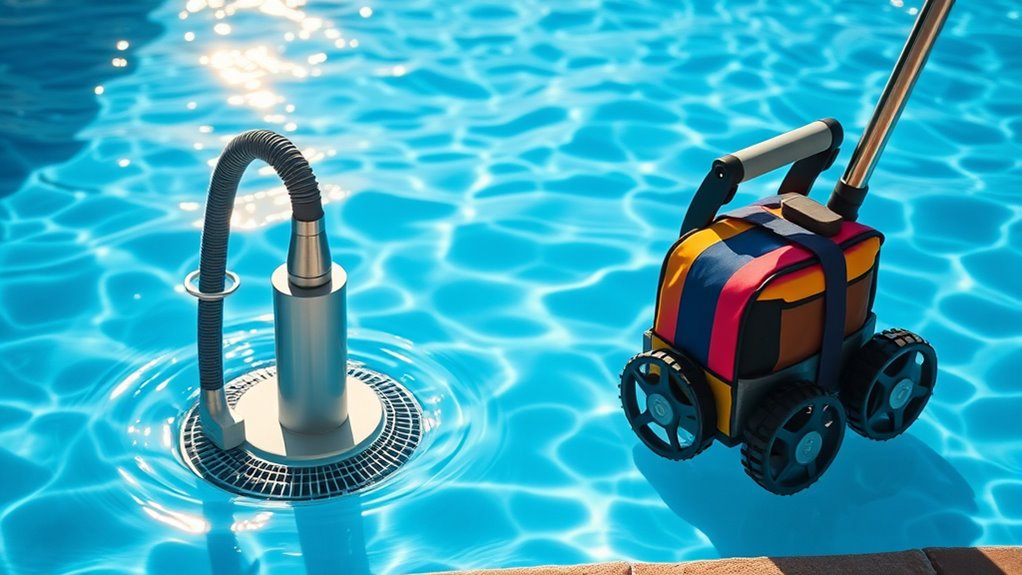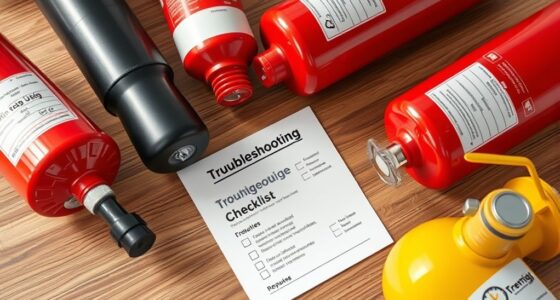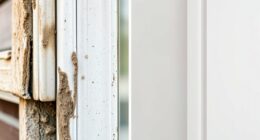Suction and pressure pool cleaners both keep your pool clean but work differently. Suction cleaners connect to your skimmer or suction line and gently vacuum debris into a filter bag, making them easy to set up and ideal for smaller or irregular pools. Pressure cleaners use water pressure to vigorously scrub the pool’s floor and walls, great for bigger pools and heavy debris. To learn which cleaner suits your pool best, keep exploring these key differences.
Key Takeaways
- Suction cleaners use vacuum power from the pool’s filtration system, while pressure cleaners rely on water pressure from a booster pump.
- Suction cleaners are easier to install and better for irregularly shaped pools; pressure cleaners are more complex but handle heavy debris effectively.
- Pressure cleaners clean faster and are more effective on larger debris and pool walls; suction cleaners are gentler and suited for detailed cleaning.
- Pressure cleaners generally cost more and require more maintenance, whereas suction cleaners are simpler and more budget-friendly.
- For small, irregular pools, suction cleaners are ideal; larger, debris-heavy pools benefit more from pressure cleaners.
How Suction and Pressure Pool Cleaners Work

Suction and pressure pool cleaners operate differently, but both rely on the movement of water to clear debris from your pool. Suction cleaners connect to your skimmer or dedicated suction line, creating a vacuum that pulls water and debris from the pool surface into a filter bag. They move smoothly across the pool, efficiently collecting leaves, dirt, and small debris. Their design simplicity often makes them easier to maintain and operate, especially for smaller pools. Additionally, their cost-effectiveness makes them a popular choice among pool owners seeking reliable cleaning solutions. Pressure cleaners, on the other hand, use water pressure from a booster pump or the pool’s return jet to propel themselves around the pool. They tend to be more aggressive on the pool surface, dislodging stubborn dirt and larger debris. Both types depend on water flow to function, but their methods of debris collection and movement differ, influencing how effectively they clean your pool. Additionally, the contrast ratio of a pool cleaner’s performance can impact how well it handles different types of debris and surface conditions.
Installation and Setup Differences

Installing suction and pressure pool cleaners involves different setup processes that can affect how easily you get your pool clean. Suction cleaners typically connect directly to the skimmer or dedicated suction line, requiring you to secure the hose properly to maintain consistent water flow. Pressure cleaners, on the other hand, connect to a dedicated pressure port, often needing a separate booster pump or filter port. Proper hose connection is vital in both types to guarantee ideal water flow and cleaner mobility. Ensuring the correct installation procedures are followed helps prevent operational issues and maximizes cleaning efficiency.
Cleaning Performance and Effectiveness

When it comes to cleaning performance, pressure pool cleaners often outperform suction models by delivering more vigorous and thorough debris removal. Their powerful jets propel the cleaner quickly across the pool floor and walls, increasing cleaning efficiency. This enhanced movement allows them to pick up larger debris and stubborn dirt that suction models might miss. Pressure cleaners typically cover more ground in less time, making them ideal for pools with heavy debris buildup. However, their strength can sometimes cause missed spots if not properly calibrated. Suction cleaners, on the other hand, tend to be gentler but can struggle with larger debris and uneven surfaces. Overall, pressure cleaners provide more effective cleaning performance, especially for pools with significant debris or challenging surfaces.
Cost and Maintenance Considerations

While pressure pool cleaners often have higher upfront costs, they can also entail greater ongoing expenses due to more complex maintenance requirements. You’ll find a wider range of pricing options, but expect to spend more on maintenance over time. Replacement parts like hoses, valves, and gears tend to be pricier and may need frequent replacement, especially if the cleaner operates frequently. Additionally, complex systems require regular inspections and occasional repairs, increasing your maintenance efforts and costs. Proper maintenance helps prolong the cleaner’s lifespan and guarantees peak performance, but it’s essential to factor in these ongoing costs when choosing between suction and pressure models. Incorporating maintenance strategies can also help monitor and optimize your pool cleaning expenses effectively, especially as digital literacy programs encourage the use of technology for efficiency. Considering Kia Tuning techniques, such as ECU remapping and suspension upgrades, can serve as an analogy for optimizing your pool cleaning system for better performance and cost-effectiveness.
Ease of Use and Convenience

When choosing a pool cleaner, you’ll want one that’s easy to set up and operate without hassle. Consider how accessible maintenance is and whether routine tasks fit easily into your schedule. Simplifying these aspects can save you time and frustration during your pool cleaning routine. Additionally, selecting a user-friendly design can make routine cleaning more straightforward and less time-consuming. To ensure ongoing efficiency, look for models with easy filter access for quick maintenance. For example, understanding the horsepower of the cleaner can help determine its power and effectiveness. Furthermore, choosing a model with energy-efficient features can reduce operational costs over time. Being aware of the latest innovations in pool cleaning technology can also help you make a more informed decision.
Setup and Operation
Setting up and operating pool cleaners is generally straightforward, but the ease varies between suction and pressure models. Suction cleaners connect to your skimmer or dedicated vacuum port, needing minimal assembly, while pressure cleaners require a dedicated return line and hose connection. Water flow is critical for both types, impacting cleaning efficiency. Proper hose length ensures the cleaner covers the entire pool surface without tangling or losing suction. Ensuring correct product features like hose length and connection points can significantly improve performance. Proper water flow and pressure regulation are essential for optimal cleaning results. Additionally, Volkswagen Tuning techniques such as ECU remapping can optimize engine performance, similar to how proper setup enhances pool cleaner efficiency. – Adjust the hose length to match your pool size – Ensure secure connections to prevent leaks – Check water flow rates for optimal performance. A thorough understanding of pool system components can help troubleshoot and improve overall cleaning effectiveness.
Maintenance and Accessibility
Maintaining your pool cleaner’s performance hinges on ease of use and convenience. Regularly replacing filters ensures ideal cleaning, so choose models with straightforward filter replacement. Storage options also matter; compact designs fit easily in your shed or closet and prevent damage. Additionally, selecting a cleaner with easy maintenance features can further streamline your upkeep routine. Incorporating user-friendly controls can also make operation more intuitive and reduce maintenance time. Staying informed about automation in business can help you understand the benefits of integrating smart features into pool cleaning devices, enhancing efficiency. Regularly reviewing product specifications can help ensure your cleaner remains effective over time. Understanding relationships and the importance of clear communication can also be beneficial if you encounter issues with your device or service provider, ensuring smoother resolutions.
Suitability for Different Pool Types

Choosing the right pool cleaner depends heavily on your pool’s type, as suction and pressure cleaners each excel in different environments. Larger pools with more debris may benefit from pressure cleaners, which handle heavier messes more efficiently. Smaller or irregularly shaped pools are often better suited for suction cleaners, thanks to their maneuverability. Consider your pool size and debris type when selecting a cleaner:
- Pool size: Larger pools need powerful, efficient cleaners like pressure models.
- Debris type: Heavy leaves or dirt are better managed by pressure cleaners.
- Pool shape: Irregular shapes favor suction cleaners for better navigation.
- Dog breeds can influence the type of cleaner you choose if your pet tends to jump into the pool, as certain breeds may shed more or have different swimming habits. Additionally, understanding your pool’s filtration system can help determine which cleaner will operate most effectively and reduce maintenance issues. Properly matching your pool type with the appropriate cleaner ensures optimal performance and longevity. For example, some cleaner models are specifically designed to work with certain filtration systems, improving efficiency and lifespan. It is also important to verify that the cleaner is compatible with your pool’s certifications and endorsements to ensure quality and reliability.
Frequently Asked Questions
Which Type of Cleaner Is Better for Large Pools?
For large pools, choosing the right cleaner depends on your pool size and cleaning efficiency needs. Pressure pool cleaners often handle bigger pools better because they cover more area quickly and are powerful enough to clean large surfaces effectively. Suction cleaners might take longer, but they work well for moderate cleaning. If you want faster, more efficient cleaning for a large pool, a pressure cleaner is usually the better choice.
Can Suction and Pressure Cleaners Be Used Together?
You can definitely use suction and pressure cleaners together for combined cleaning, offering dual operation benefits. This approach helps cover more ground and tackles different types of debris efficiently. By combining the two, you maximize cleaning power and reduce time spent on maintenance. Just make certain your pool’s plumbing supports both systems simultaneously, and you’ll enjoy a more thorough clean with less effort.
How Long Does Installation Typically Take?
During the installation process, you can expect it to take about a few hours to a full day, depending on your pool’s setup. The time estimate includes connecting hoses, attaching the cleaner, and making sure everything runs smoothly. If you’re handy, you might do it faster, but professional installation can save you time and guarantee proper setup. Overall, plan for a dedicated period to get your cleaner up and running efficiently.
Do These Cleaners Require Regular Filter Replacements?
You might find it interesting that filter maintenance and replacement schedules often run in sync with your pool’s use. These cleaners typically need regular filter replacements to stay efficient, usually every few months, depending on debris and filter type. By sticking to a routine, you guarantee peak cleaning performance and prolong your equipment’s life, making pool upkeep smoother and more enjoyable for you.
Are There Eco-Friendly Options Available Within These Types?
You’ll find eco-friendly alternatives among pool cleaners that prioritize biodegradable cleaning components and energy efficiency. Many models now feature environmentally conscious designs, reducing chemical use and power consumption. Look for brands that advertise biodegradable cleaning parts or use sustainable materials. These eco-friendly options help you maintain your pool while minimizing environmental impact, making it easier to enjoy a clean pool with a greener, more sustainable approach.
Conclusion
Choosing between suction and pressure pool cleaners is like picking the right tool for a job—you’ll want one that fits your needs perfectly. Both types have their strengths, whether it’s efficiency or ease of use. Consider your pool size, budget, and maintenance preferences. By understanding these key differences, you can make an informed decision. Ultimately, the right cleaner will keep your pool sparkling clean, just like a well-tuned machine working smoothly.









